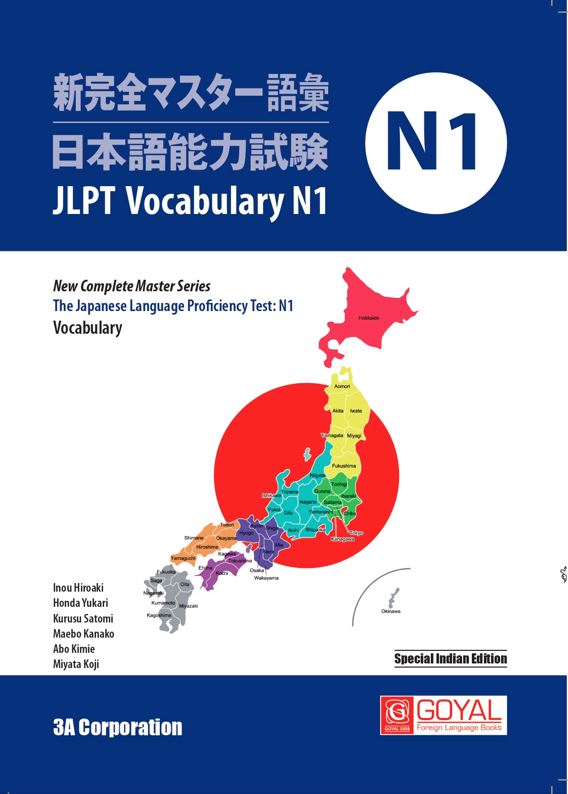Product Details
- Author : Inou Hiroaki, Honda Yukari, Kurusu Satomi, Maebo Kanako, Abo Kimie, Miyata Koji
- Binding : Paperback
- ISBN-10 : 8119109166
- ISBN-13 : 9788119109166
- Language: Japanese
- Level : Adolescent/Adult
- Pages : 208
- Publisher : Goyal Publishers & Distributors Pvt. Ltd
- Publishing Date: 2023
- Size : 26 x 18.1 x 1.7 cm
- Subtitle : Book
- Subject : Japanese
- Weight : 450 gm
ABOUT THE BOOK
日本語能力試験は、1984年に始まった。日本語を母語としない人の日本語能力を 定し認定する試験です。 受験者が年々増加し、現在では世界でも大規模の外国語の 試験の一つとなっています。 試験開始から20年以上経過する間に、学習者が多様化し、 日本語学習の目的も変化してきました。 そのため、2010年に新しい「日本語能力試験」 として内容が大きく変わりました。 新しい試験では知識だけでなく、実際に運用でき る日本語能力が問われます。
本書はこの試験のNIレベルの問題集として作成されたものです。
新しい 「日本語能力試験」では、語彙に関して、まず、以下の3点が、今までの
試験と大きく変わりました。
①試験の出題範囲となる語が約 10,000語から約 15,000語に増えた。
②どの語が試験に出題されるかを示す語彙リストがすべて非公開となった。 ③日本語を学ぶ人が、どのような状況 (目標言語使用領域)で、何のために (課題)、 日本語を使うかという観点から、試験に出題される語彙の選び直しが行われた。 そして、このような試験の変化に対応できるよう、 本書は以下のような特徴を備え
た本になっています。
■本書の特徴
① 新しい 「日本語能力試験」で語彙を選ぶ際に使われた資料と同じNTTデータベー
スシリーズ 「日本語の語彙特性」 (三省堂) 等、複数の資料を用い、語彙 (全 1,613
語)の選出を行った。
② 日本語を学ぶ人がどのような状況で、何のために日本語を使うかを想定し、話題
別に言葉を学ぶ章を設けた。 (本書第1部)
③ 過去20年分の問題や新しい試験のサンプルなどを分析して、「類義語」 「オノマ トベ」 「語形成」など、さまざまな性質別に言葉を学ぶ章を設けた。 (本書第2部)
④例文や問題の作成にあたり、インターネット上の大規模言語データベース=コー
バス (Sketch Engine) 等を用い、 自然で有用性の高い日本語の文を示すようにした。 ⑤試験に向けた実践的な練習ができるよう、本書の最後に模擬試験を2回分付した。
本書は今までにない特徴を備えた問題集になっていると確信しています。 ぜひ手に 取って、日本語の語彙力を磨くために使っていただければと思います。
Translation
The Japanese Language Proficiency Test started in 1984. This test determines and certifies the Japanese language proficiency of non-native speakers of Japanese. The number of test takers has increased year by year, and it is now one of the largest foreign language exams in the world. In the more than 20 years since the test started, learners have diversified, and the purpose of learning Japanese has also changed. Therefore, in 2010, the contents of the new “Japanese Language Proficiency Test” changed significantly. The new test tests not only knowledge, but also practical Japanese language proficiency.
This book was created as a collection of NI-level questions for this exam.
In the new Japanese-Language Proficiency Test, regarding vocabulary, the following three points are
The exam has changed a lot.
(1) The number of words covered in the exam has increased from about 10,000 to about 15,000.
(2) Vocabulary lists that show which words appear on exams are all closed to the public. (3) Vocabularies used in the exam were reselected from the perspective of what kind of situation (target language usage area) and for what purpose (task) Japanese learners use Japanese. . In order to respond to such changes in testing, this manual has the following features.
It has become a book.
■ Features of this book
① The same NTT database as the material used to select vocabulary for the new Japanese Language Proficiency Test
Vocabulary (total 1,613
language) was selected.
(2) Think about what kind of situations Japanese learners use Japanese for and what topics they use it for.
A separate chapter on language learning was provided. (Part 1 of this book)
③ By analyzing questions from the past 20 years and samples of new exams, we created chapters for learning words according to various characteristics, such as "synonyms," "onomatopoeia," and "word formation." (Part 2 of this book)
(4) When creating example sentences and problems, we used a large-scale language database on the Internet,
By using bus (Sketch Engine), etc., I tried to show natural and highly useful Japanese sentences. (5) Two mock exams are included at the end of this book so that students can practice practically for the exam.
I am convinced that this book is a problem collection with unprecedented features. I hope that you will pick it up and use it to improve your Japanese vocabulary.













